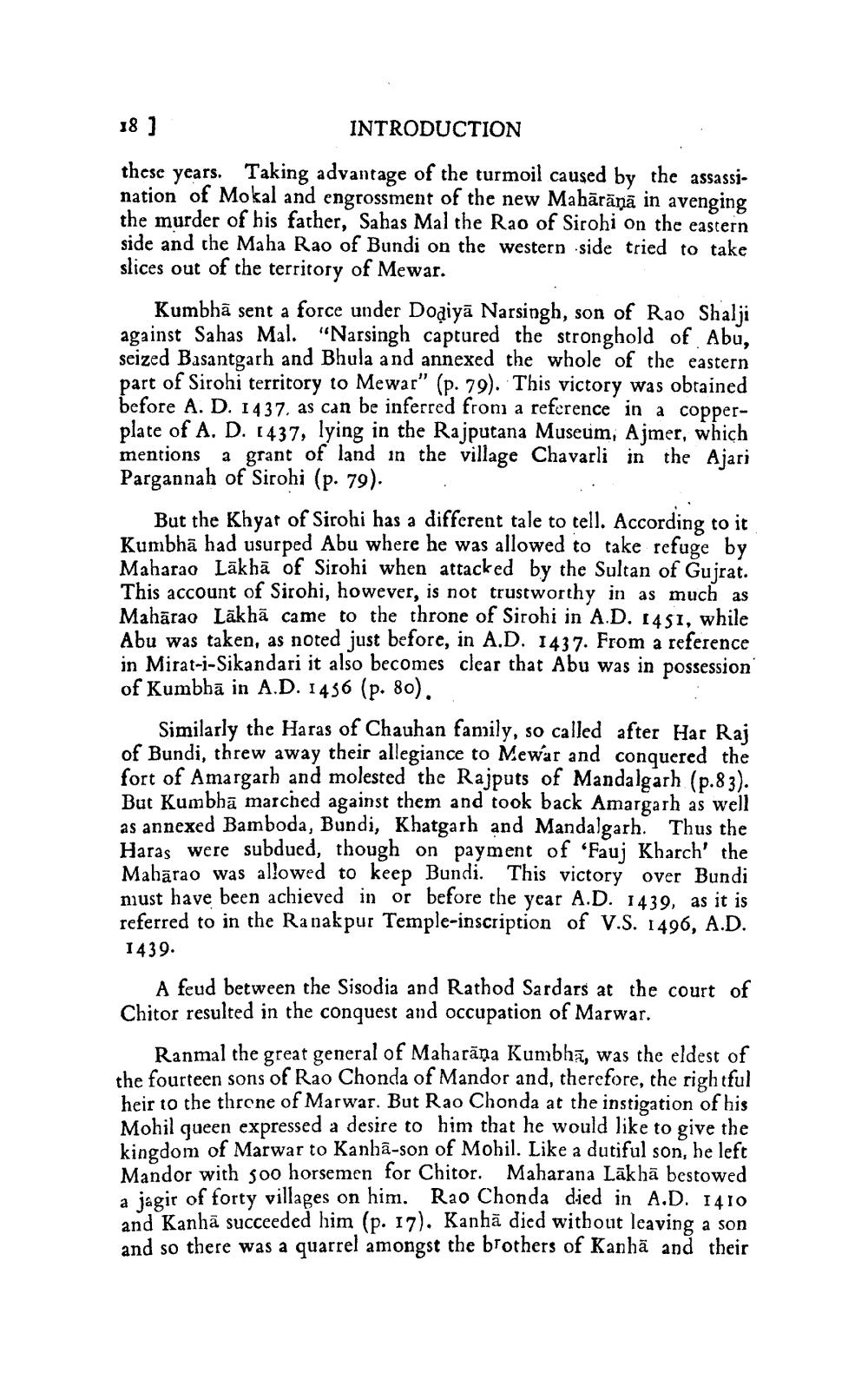________________
18 ]
INTRODUCTION
these years. Taking advantage of the turmoil caused by the assassination of Mokal and engrossment of the new Mahārāṇā in avenging the murder of his father, Sahas Mal the Rao of Sirohi on the eastern side and the Maha Rao of Bundi on the western side tried to take slices out of the territory of Mewar.
Kumbhā sent a force under Doqiyā Narsingh, son of Rao Shalji against Sahas Mal. "Narsingh captured the stronghold of Abu, seized Basantgarh and Bhula and annexed the whole of the eastern part of Sirohi territory to Mewar” (p. 79). This victory was obtained before A. D. 1437, as can be inferred from a reference in a copperplate of A. D. 1437, lying in the Rajputana Museum, Ajmer, which mentions a grant of land in the village Chavarli in the Ajari Pargannah of Sirohi (p. 79).
But the Khyat of Sirohi has a different tale to tell. According to it Kumbhā had usurped Abu where he was allowed to take refuge by Maharao Lākhā of Sirohi when attacked by the Sultan of Gujrat. This account of Sirohi, however, is not trustworthy in as much as Mahara, Lākhā came to the throne of Sirohi in A.D. 1451, while Abu was taken, as noted just before, in A.D. 1437. From a reference in Mirat-i-Sikandari it also becomes clear that Abu was in possession of Kumbhā in A.D. 1456 (p. 80). Similarly the Haras of Chauhan family. so called after Har Rai
so called after Har Raj of Bundi, threw away their allegiance to Mewar and conquered the fort of Amargarh and molested the Rajputs of Mandalgarh (p.83). But Kumbha marched against them and took back Amargarh as well as annexed Bamboda, Bundi, Khatgarh and Mandalgarh. Thus the Haras were subdued, though on payment of 'Fauj Kharch' the Mahārao was allowed to keep Bundi. This victory over Bundi must have been achieved in or before the year A.D. 1439, as it is referred to in the Ranakpur Temple-inscription of V.S. 1496, A.D. 1439.
A feud between the Sisodia and Rathod Sardars at the court of Chitor resulted in the conquest and occupation of Marwar.
Ranmal the great general of Maharāņa Kumbha, was the eldest of the fourteen sons of Rao Chonda of Mandor and, therefore, the rightful heir to the throne of Marwar. But Rao Chonda at the instigation of his Mohil queen expressed a desire to him that he would like to give the kingdom of Marwar to Kanha-son of Mohil. Like a dutiful son, he left Mandor with soo horsemen for Chitor. Maharana Lāk ha bestowed a jagir of forty villages on him. Rao Chonda died in A.D. 1410 and Kanhā succeeded him (p. 17). Kanhä died without leaving a son and so there was a quarrel amongst the brothers of Kanhã and their




